Would a watch by any other name still tick and tock? Would our passion for mechanisms, design, and craftsmanship sputter and die if the word were a different one? Would the inherent qualities of a timepiece cease to exist if it was called a “schpoogelmuffer”?
Well, it is possible, and fundamentally we can never know how the world would feel about haute schpoogelmuffology even if it was a thing.
But what we can know is how names matter once they are established and how changing a name, or even appearing to change a name, can dramatically shift public perception. Oh, the public: a fickle mistress of illogical decisions and rash conclusions, how they torment everyone in marketing!
In the business world, altering a name has not always gone well; whether it be a product or the entire company identity, it is clear that people don’t like change. The most recent example is IHOP, which somehow decided that a name change was in order, but sheepishly thought “nothing too drastic.” The restaurant chain changed its name from the International House of Pancakes (IHOP) to the International House of . . . wait for it . . . Burgers (IHOB).
The public, confounded, confused and upset, rightly ridiculed the company for lazily trying to rebrand itself to draw attention to its burger and other offerings. Burgers aren’t really a breakfast food, so the change didn’t resonate with diners and it ruined the graphics of the logo so that had to be redesigned as well.
Originally the O and P of IHOP had a red semicircle underneath to create a smiling face, with the descender of the P acting as the nose. That was clever, rivaling Amazon and FedEx for subtle yet clear and specific graphic design. Now the logo is muddled as the lowercase p becomes b, the perfect subtle face is lost.
As bad as the IHOP name change went in the public eye (it was changed back after a month, turns out it was also a PR stunt), some name changes work splendidly – like Apple Computer dropping the “Computer” part when it launched the iPhone, signaling that it knew computers would become a smaller and smaller percentage of its business (which has ultimately become true).
The key point to take away is that name changes should be considered in the context of brand recognition and the significance value in brand-name longevity. Sometimes, brands branch off and add to the name with a complimentary line, like Dodge making Ram Trucks its own company and Netflix separating the streaming services from the home DVD delivery service (which failed and was scrapped).
In the watch industry, this happens as well: Baume & Mercier spun off entry-level watches into Baume in 2018, and, perhaps most famously, Rolex founder Hans Wilsdorf created Montres Tudor SA as the affordable baby brother of Rolex in 1946.
Sometimes the spinoff isn’t as fully fleshed out, and a new line from a brand represents a test of the waters for a different direction. This occurred at Baselworld 2018 when young boutique brand Akrivia launched its Chronomètre Contemporain, the very first timepiece in the Rexhep Rexhepi Collection.
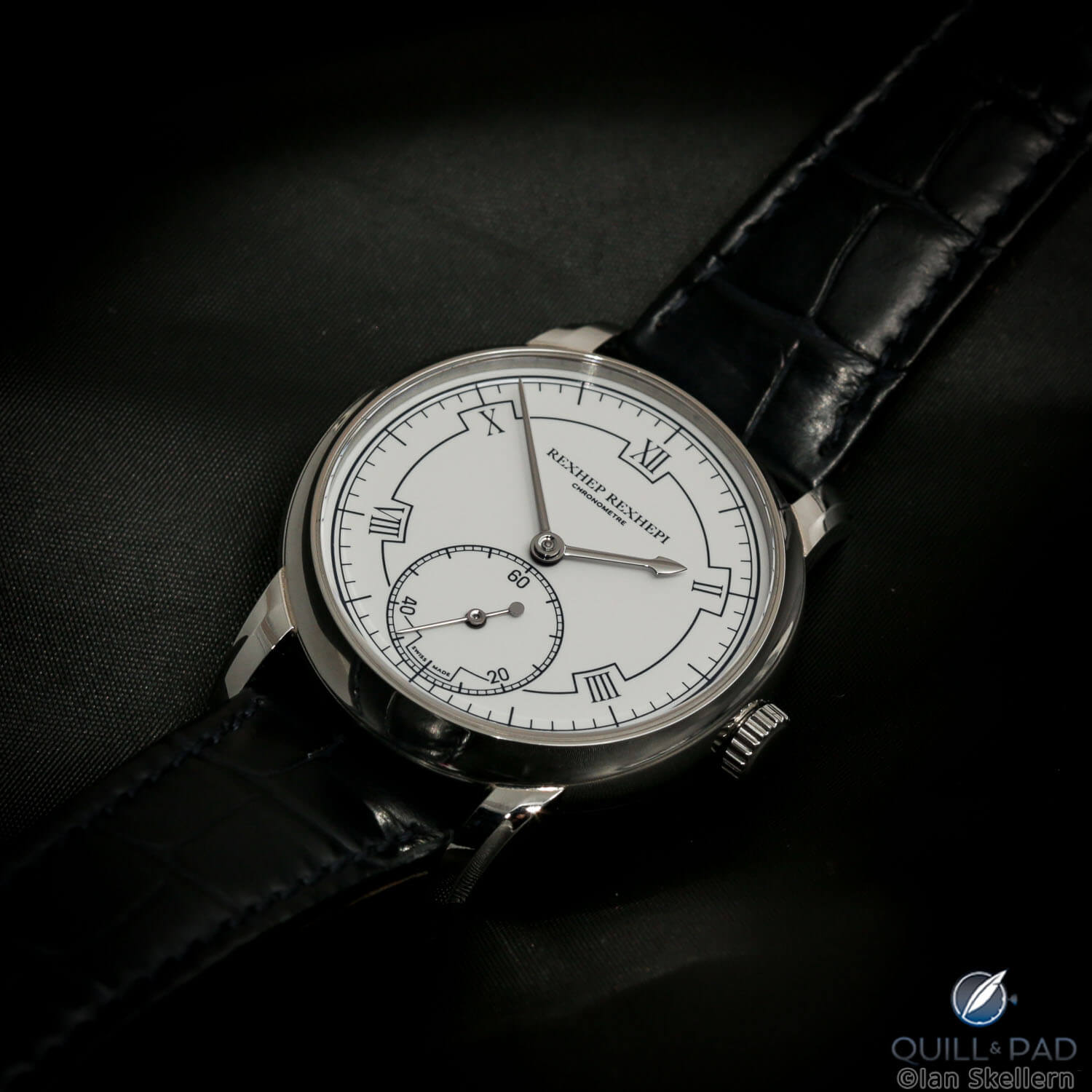
Rexhep Rexhepi Chronomètre Contemporain by Akrivia
The collection is a dramatic shift from the standard Akrivia fare (which is far from standard), a quasi-signature collection that provides a much more classic option for fans of the brand. Honestly, it is pretty normal in my eyes that Rexhep Rexhepi would want his name on his watches, and so creating a line with that seems like a logical step.
It is only because the watch looks so different from earlier models and lacks the Akrivia logo on the dial that might lead some to worry that Akrivia is switching gears. If so that could indeed confuse potential customers.
Cha, cha, cha, changes . . .
The new Chronomètre Contemporain from Akrivia is a fantastic design and a sweet idea considering the brand is relatively new (though celebrating its sixth anniversary with the most recent launch) and is still building name recognition. Akrivia is known largely to watch nerds, and the brand’s success, I guess, is based on true appreciation for what Rexhep and his brother Xhevdet create.
And as its social media reach expands, more and more people are brought into the know.
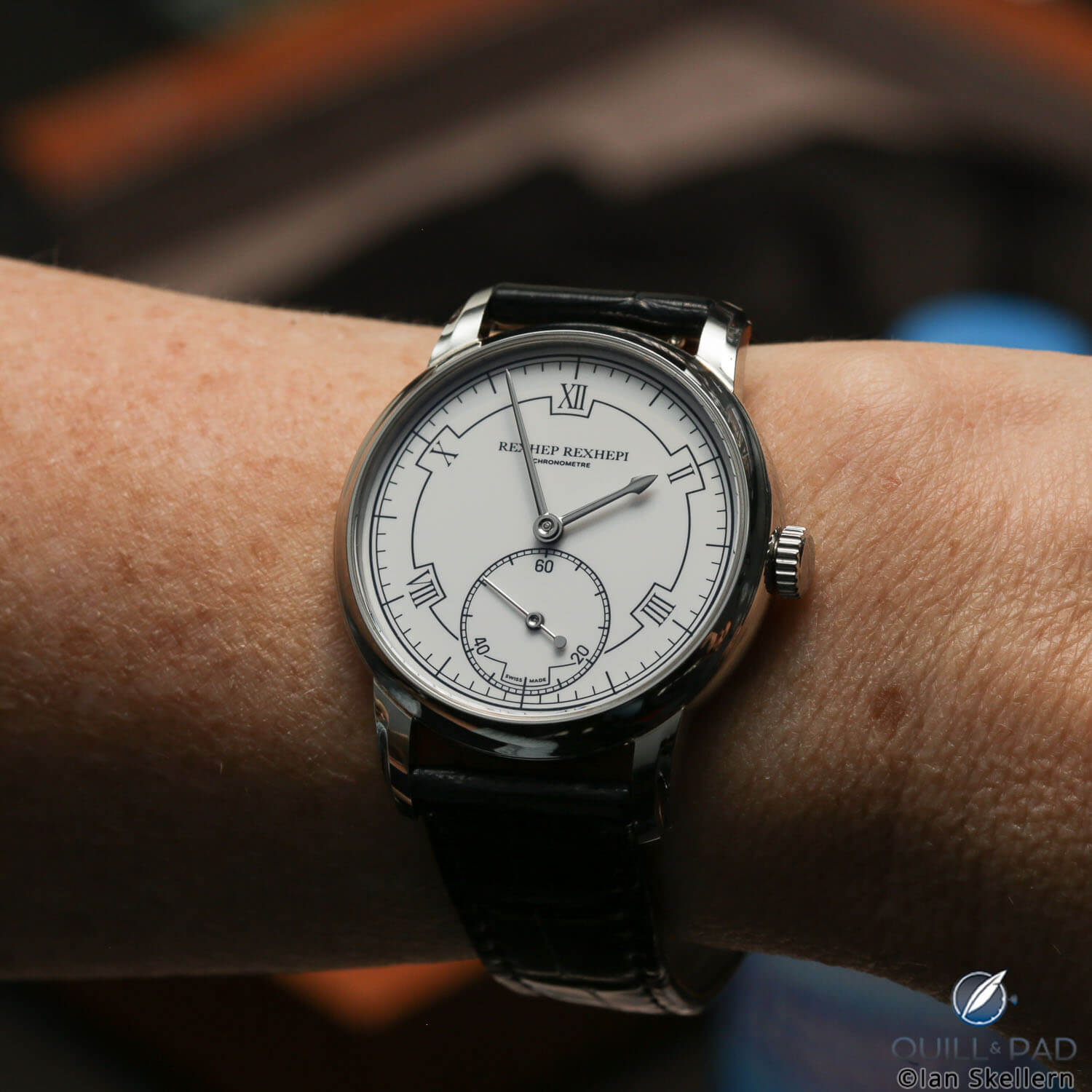
Rexhep Rexhepi Chronomètre Contemporain by Akrivia on the wrist
The new Rexhep Rexhepi collection is going to help with that, as no matter what there are lots of people that will pass by a “normal” Akrivia piece without so much as a second glance simply because it isn’t their cup of tea.
So this new collection isn’t a change in the business direction per se, it is actually an expansion to hopefully reach new markets, new clients, and possibly generate new exposure. A shift like this after 20 years might actually be risky, but after six it just feels calculated.
The inspiration came from Rexhep himself (no surprise there) as he has always had a fascination with and love for officer’s watches from the 1940s. The Chronomètre Contemporain is an interpretation of these watches with an Akrivia slant and movement, which makes it just a little different. It does not remind you of the Akrivia we have come to love, but if you have ever had the opportunity to chat with Rexhep, it does mesh with who he is as a person.
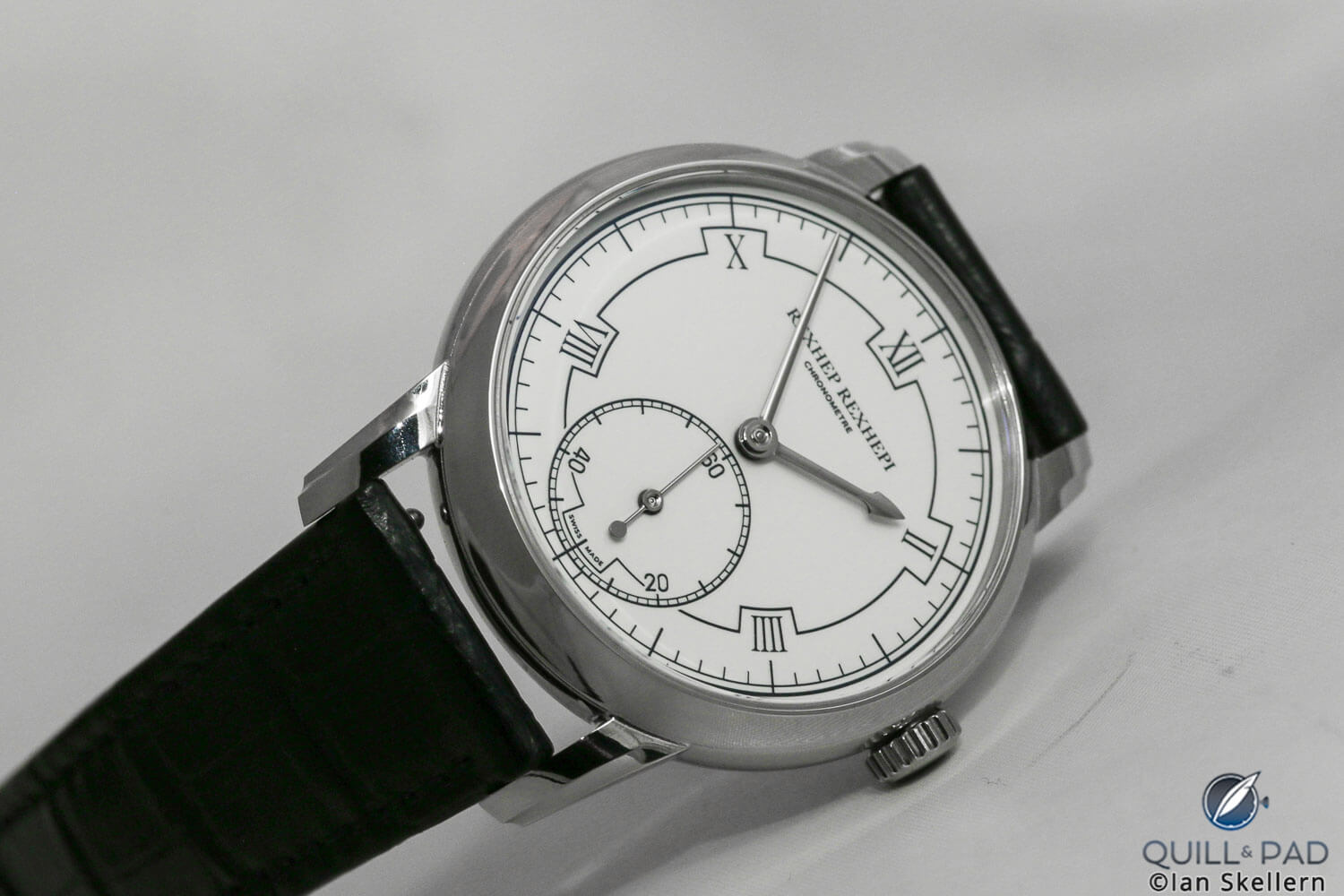
Rexhep Rexhepi Chronomètre Contemporain by Akrivia
Akrivia Chronomètre Contemporain
The watch is a straightforward three-hander with a large seconds subdial at 6 o’clock designed in an Art Deco-inspired asymmetrical layout. The hour indications include five Roman numerals framed by alternating half windows connected around the dial periphery.
The design continues inside the subdial, but instead of a Roman numeral there is a tiny “Swiss Made” indication. This keeps the inside of the subdial from being too busy and ensures visual continuity around the dial.
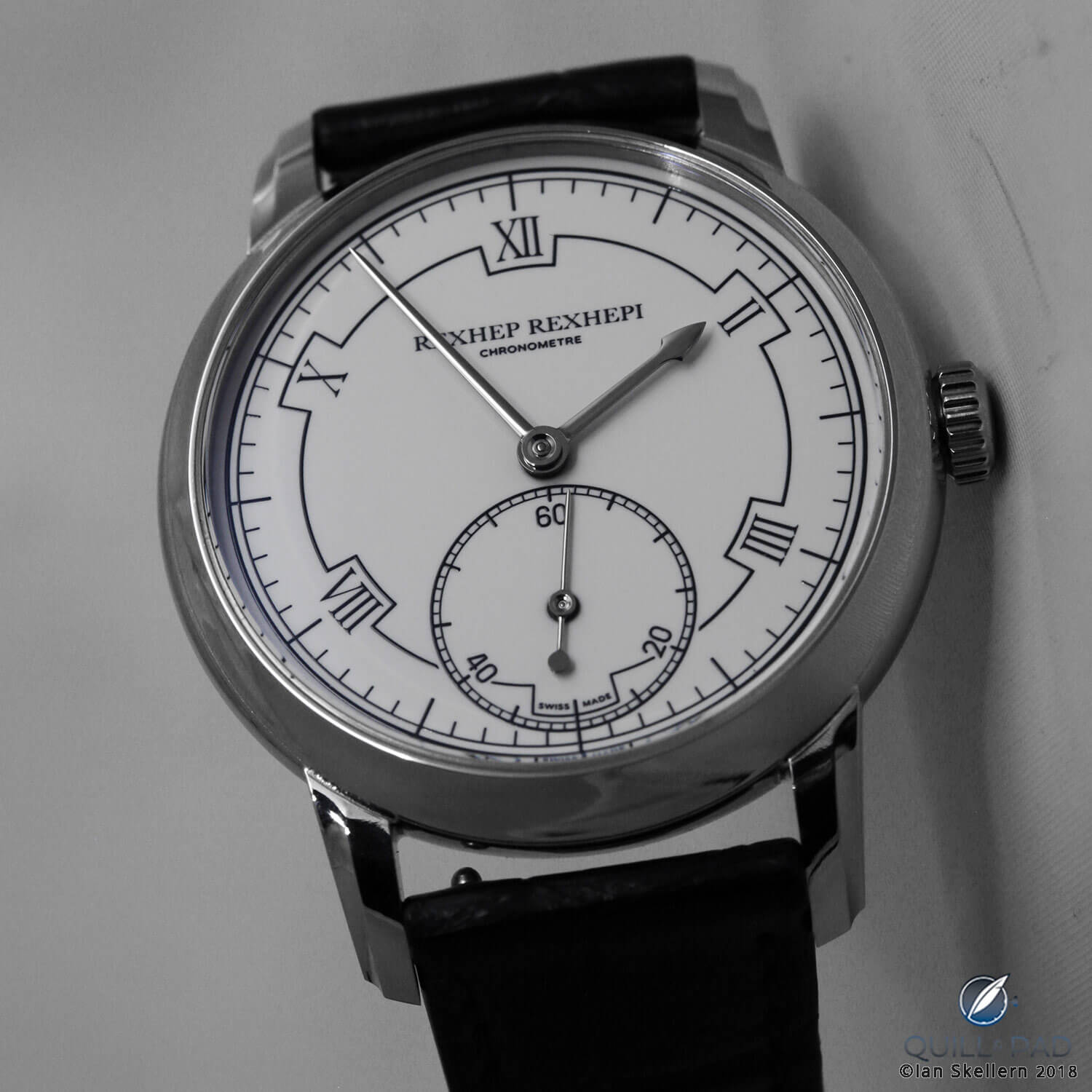
Rexhep Rexhepi Chronomètre Contemporain by Akrivia
The subdial is rather large, squeezing between the central staff for the hour and minute hands and the edge of the minute track. The design of the subdial takes priority as the larger dial design features are cut away by the subdial shape with one subtle but key exception, the 30-minute hash mark doubles as the 30-second hash mark of the subdial, tying the two designs together in the smallest of ways.
As stated before, the name Akrivia is absent from the dial, but this makes design sense when considering all the details.
All previous Akrivia watches have had the name engraved on some applied plaque or window structure with no printing ever appearing on the handmade dials. Since the Chronomètre Contemporain has a pad-printed dial, the addition of “Akrivia” would have been odd and not in keeping with the design language of the piece.
Of course, a flat graphical name could have appeared but since the point of the piece is more of a signature watch, something akin to a classic Patek Philippe (or the Rexhepi brothers’ own Pièce Ecole watches), the name Akrivia was left off in favor of “Rexhep Rexhepi” in a classic serif font.
Underneath the name is the word “chronometre,” and it is there not just because this whole timepiece is founded on the idea of classic chronometer watches, but because the Caliber RR-01 inside can be certified by the Besançon Observatory on request, where it will obtain a Bulletin de marche de chronométrie certifying that it met ISO 3159 standards after a 16-day test period.
This is the first true chronometer offered by Akrivia and its classicalness cannot be denied.
Mechanical awesomeness in a simplified package
Caliber RR-01 is also no mere time-only chronometer-grade movement as it features a hefty 100-hour power reserve from a single barrel and a stop-seconds/zero-reset mechanism for precise time setting.
When the crown is pulled the reset mechanism, which functions similarly to the “all-or-nothing” activation mechanism used in grande sonneries to prevent partial activation, stops the balance and returns the second hand to zero using a heart cam while the time is set. A dual-wing spring component ensures that both actions happen simultaneously and fully, guaranteeing perfect setting every time.
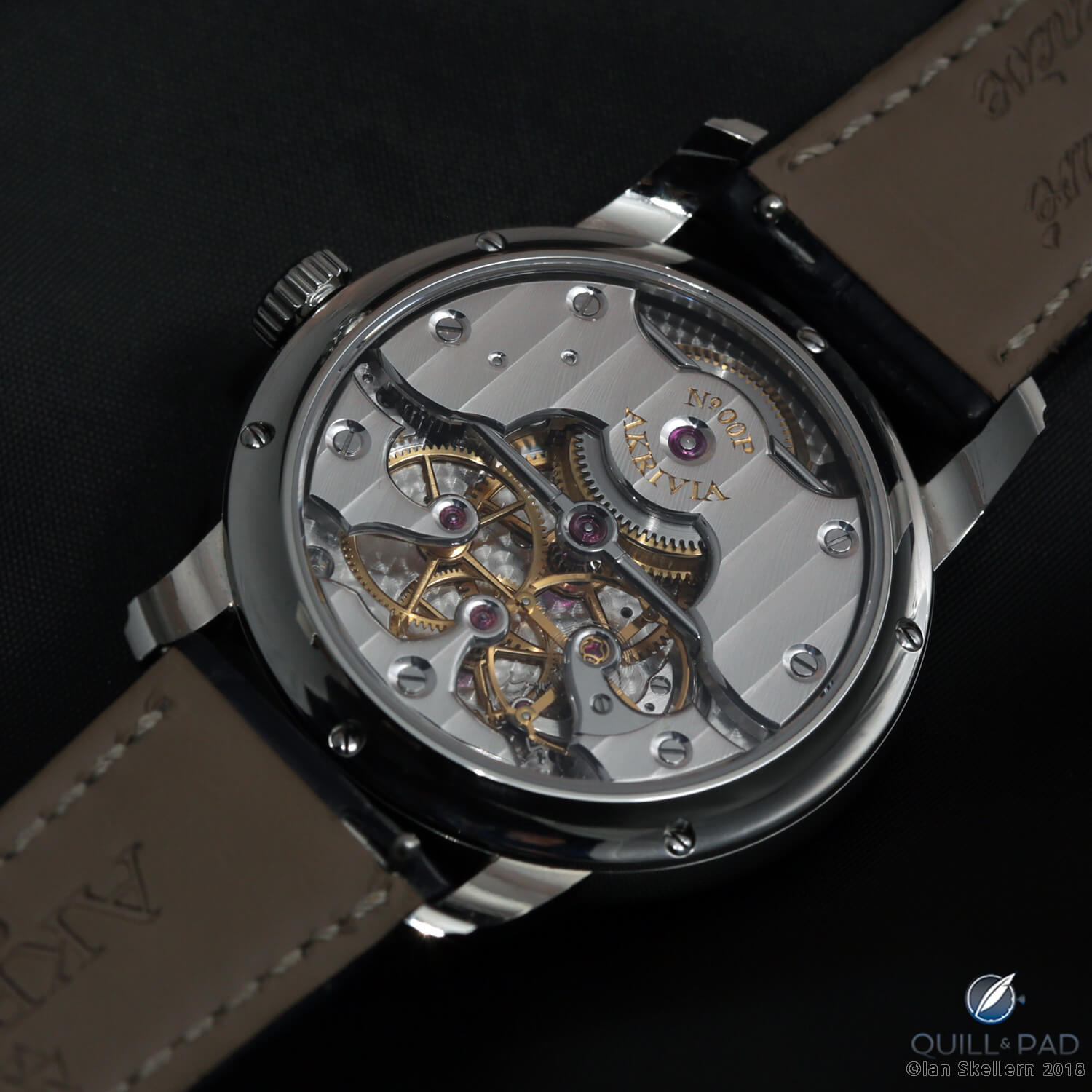
View through the display back of the Rexhep Rexhepi Chronomètre Contemporain by Akrivia
The movement looks rather straightforward, but the execution is absolutely top notch and the finishing is superb, sharing the usual Akrivia details like sharp internal angles on the bevels, black polishing, and precise details at every turn. The movement is by far the most familiar Akrivia feature as it shares design language with previous movements found in the more futuristically styled pieces.
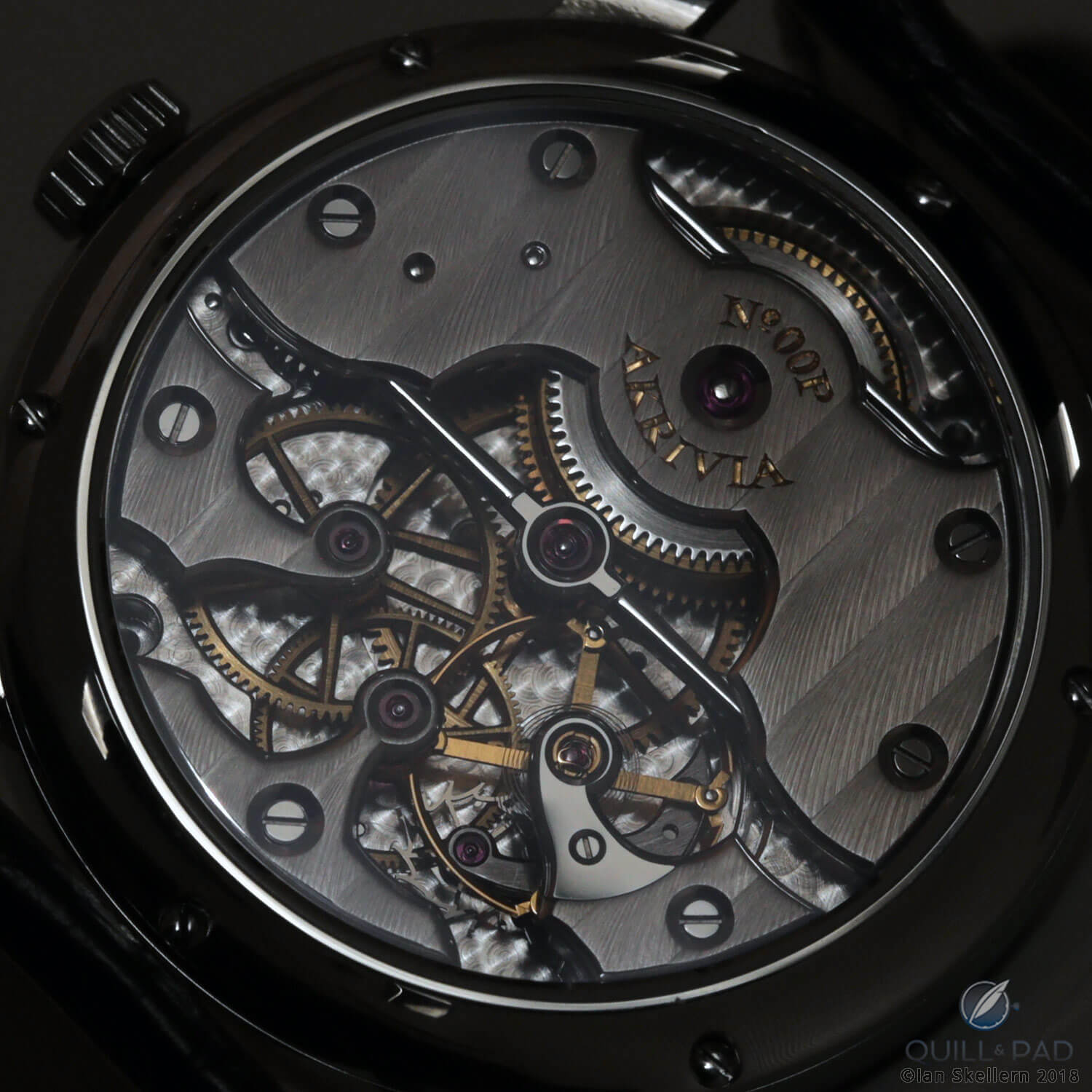
Akrivia Caliber RR-01 powers the Rexhep Rexhepi Chronomètre Contemporain
But this brings us back to the risk that Akrivia has taken: designing a watch that doesn’t look like the familiar Akrivia. The classic styling, sizing (down to 38 mm from the boutique brand’s standard 43), and branding has departed sharply from the usual Akrivia offerings. Of course many were happy to see the new option coming from the brand while others who love the Akrivia concept felt it just belonged to a different brand.
To that I say, why does a brand need to stay exactly where it started from – or even close to it? I have tons of ideas for watches, and if I were to start a brand and make all my ideas, they wouldn’t share much DNA from one piece to the next.
A tricky business
I find that new brands (at least the good ones) often fall into one of four categories.
First, there is the brand that started with one great idea and had no real plan to develop anything further besides variations on the initial concept. Kind of like a one-hit wonder in the music industry, the brand was built around a watch design idea and not a fully formed brand idea. Nothing wrong with it, but it has the potential to fade quickly. A prime example is the 4N watch – see an example in Give Me Five! Sapphire Crystal Cases At Baselworld 2016 – amazing timepiece, but a full brand it was not.
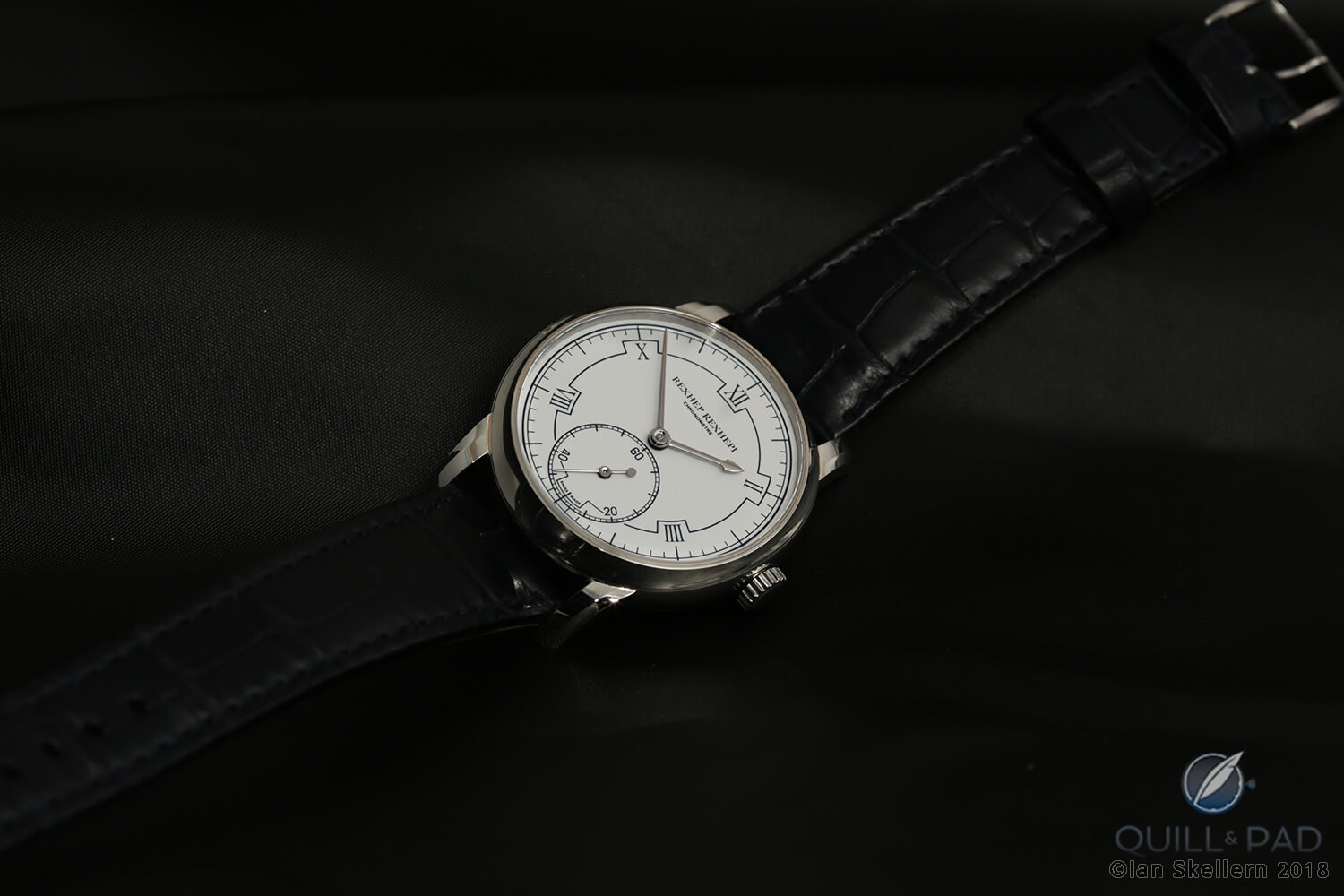
Rexhep Rexhepi Chronomètre Contemporain by Akrivia
Next, you have the brand that starts because it wants to create watches in a specific style or genre: diving watches, chiming watches, tourbillon watches, or whatever the desires dictate. These brands usually have lots of options within their self-appointed areas and yet also have the freedom to move outside this narrow focus, though they usually stay with a tried-and-true form factor. A great example is Ressence, as the initial idea was about a way of interacting with a watch, which has provided multiple avenues for exploration.
Then there is the brand that wants to create watches outside the norm, do things a bit differently, and allows itself a great amount of design freedom. Brands like MB&F, Hautlence, Urwerk, and their contemporaries prove how many ways this strategy can be implemented. And when done in a savvy manner, the brand can have real staying power as long as the market has a place for it.
And then there are watchmaker brands, where the desire to make top-quality watches with interesting or complicated mechanisms takes center stage. The brands grow organically out of ideas and designs the makers decide to develop. Andreas Strehler, Kari Voutilainen, and Akrivia fall into this category, and each finds its own path forward when it comes to what to make. These types of brands also have some of the most passionate fans, who define brand identity with the first watch or watches produced.
This means it is easy for these brands (and in truth, all brands) to become stuck in one design concept or language without the ability to do anything different at the risk of offending fans and, more importantly, clients. It takes guts, passion, and a true belief in what you are creating to deviate from what has brought you success and try something new.
Small brands technically gamble with their livelihoods when creating something entirely different. Akrivia has just shown that it wants to take that risk.
Of course I am of the opinion that every watch speaks for itself, and the quality a brand brings to a watch is independent of style, cohesiveness, or even congruity. If a brand wants to jump from uber-complicated watches to simple time-only pieces and back again, why should I judge that it does or doesn’t make sense for the brand?
Maybe it made sense based on workload or simply the personal excitement of the watchmaker or designer. Or, possibly, one watch was finished sooner than another, so why wait to reveal it?
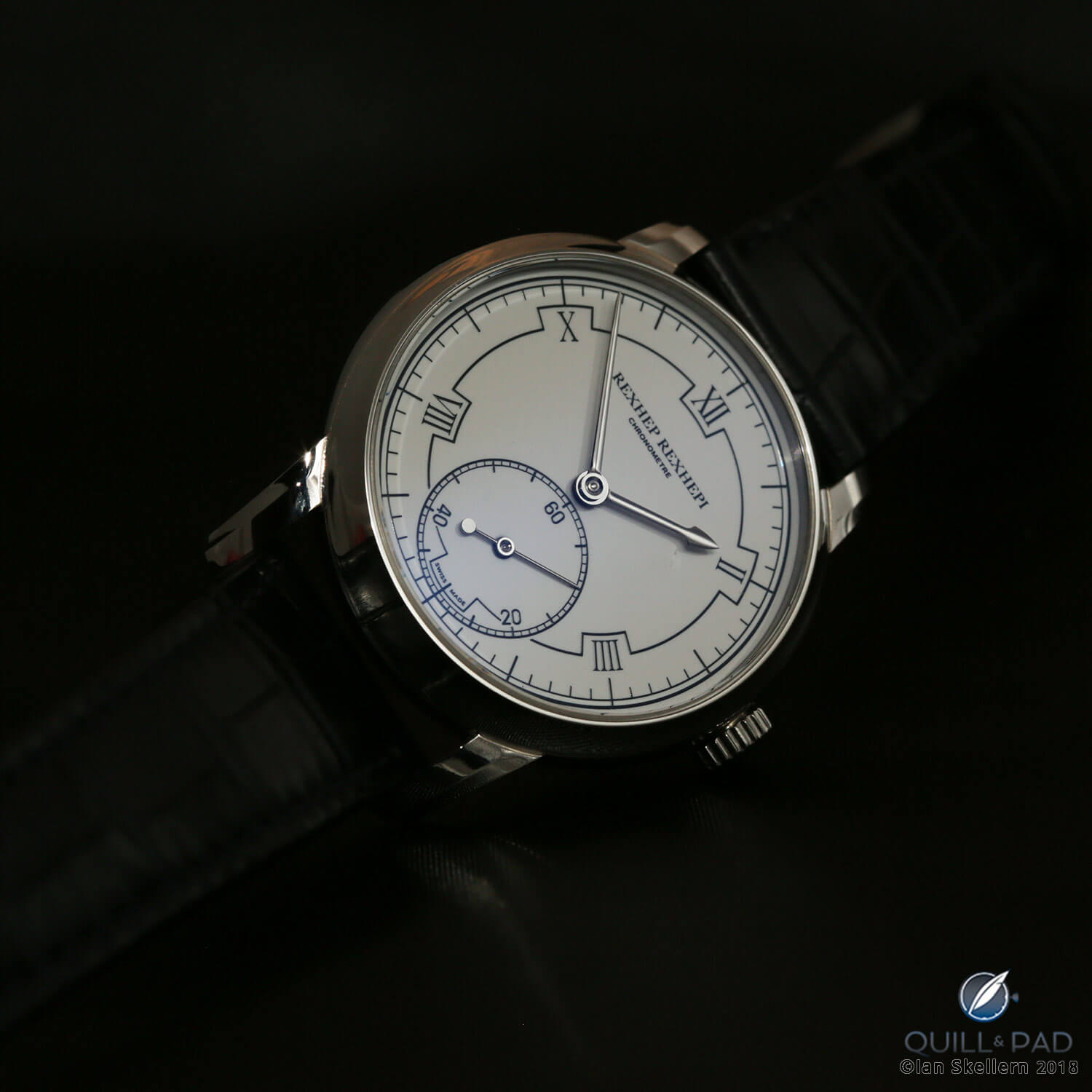
Rexhep Rexhepi Chronomètre Contemporain by Akrivia
This happens more than you think in product development, so it doesn’t surprise me when a watch brand suddenly switches gears. It’s a complex business, and I’m not privy to all the inner workings of each brand. But from an outside perspective, I can still see a top-notch product being produced by talented and passionate people.
The Chronomètre Contemporain is a darn fine watch, and coming from Akrivia I know that it can compete with some of the best names out there.
It is still early and we have yet to see how the new collection will fit within the larger Akrivia structure, but one thing is certain: if future Rexhep Rexhepi Collection pieces are as solid as this one, the brand has another winning direction to follow.
I am excited to see what comes next, but that should come as no surprise to you. I am always excited about what is going to come next in the world of watches.
So let’s break it down!
- Wowza Factor * 9.15 The wow comes from the unexpected departure for the new collection!
- Late Night Lust Appeal * 88.8 » 870.831m/s2 Sometimes it’s the simple things that keep you lusting all night!
- M.G.R. * 62.5 The implementation of Caliber RR-01 is top notch!
- Added-Functionitis * Mild It is technically time only, but it does feature stop-seconds with zero-reset function so I will give it a little bump. Still, children’s strength Gotta-HAVE-That cream is probably all that is needed!
- Ouch Outline * 10.6 Splitting a fingertip with a flat head screwdriver! Besides the tiny slotted screws in watch movements, I really dislike screws with the basic slot. They provide the most risk for damage and injury out of all drive types. Still, I would do it again if it got me a Chronomètre Contemporain!
- Mermaid Moment * First time setting the watch! A few moments setting the watch and admiring the style in conjunction with the zero-reset function is all it takes to convince you it should be a summer ceremony!
- Awesome Total * 740 Multiply the diameter of the watch in millimeters (38) with the meters of water resistance (30) and divide the result by the number of case metal options there are (2), and finally add the number of components in the movement (170) and the result is a soundly awesome total!
For more information, please visit www.akrivia.com.
Quick Facts Akrivia Rexhep Rexhepi Chronomètre Contemporain
Case: 38 x 9.5 mm, red gold or 950 platinum
Movement: manual winding Caliber RR-01
Functions: hours, minutes, hacking seconds with zero reset function
Price: CHF 55,500 in red gold; CHF 58,000 in platinum
This article was first published on September 2, 2018 at Akrivia Rexhep Rexhepi Chronomètre Contemporain: A Fork In The Road, A Pivot, Or Something Else Entirely?
You may also enjoy:
A Collector’s View: Is Akrivia Bound For Glory?
Akrivia Tourbillon Chiming Jump Hour: Manifest Destiny Or Gut Feeling?
Leave a Reply
Want to join the discussion?Feel free to contribute!





















































Awesome, unbelievable in 2020-21 era. Watch is beautiful, I’ve no words to describe, also it’s automatic is good point for watch.
Good that you left the price to the very end. A nicely done dial and case with a particularly well done mechanical movement. Does the watch match it’s asking price though? Especially when compared to others in this price range? Hmmm….
No doubt it deserves.
It’s a manual-wind watch.
These are indeed superb watches and the movement architecture and finishing never cease to fascinate me. One of these (AK06) is definitely on my list. Both the original design and the more traditional one of the RR line are beautiful but oh so different. In fact in another world I would have liked the Akrivia name on the RR line and the RR name on the AK line. I have spoken with Rex on two occasions (an extremely warm and likable person) and I have always felt that the AK line is more close to his teenage, adventurous character and this is the reason that I personally opt for this rather than the more “traditional” CC. But what is done is done! So maybe now we should be waiting for an XR line as well?